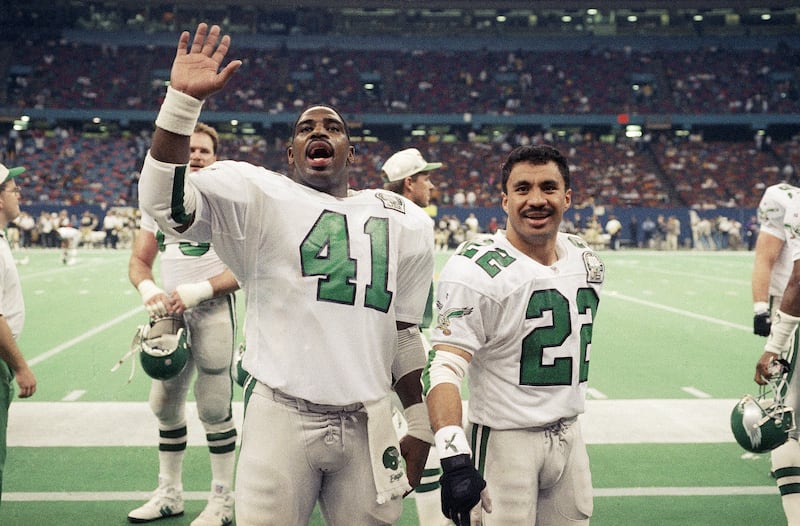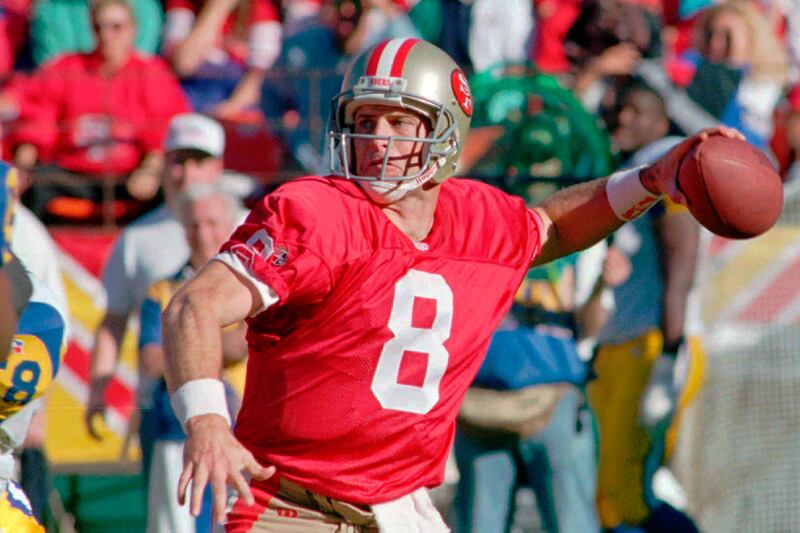Everyone loves lists, so here’s another one: The 12 best NFL players to come out of BYU. This will undoubtedly produce disagreement from readers, but here it is. The first few choices were easy, then it became increasingly difficult.
1) Steve Young (first round/1984, quarterback) — His pro career got off to a strange start. Two seasons in the USFL. Two seasons with the moribund Buccaneers (three wins total). Then he was traded to the 49ers and stood on the sideline for four years playing behind Joe Montana, although injuries to the latter provided him occasional playing opportunities. Finally, at the age of 30, he became the team’s starting quarterback, and his career took off. During the next nine years, he led the NFL in passing six times. He set an NFL single-season record for passer rating (112.8), he threw a still-standing Super Bowl record six touchdown passes to win the 1995 championship, he passed for 33,124 yards and 232 touchdowns, and rushed for 4,239 yards and 43 touchdowns (second most ever by a quarterback). He was named the NFL’s Most Valuable Player twice, and he was named first-team All-Pro three times and second-team All-Pro two times (note: unlike the Pro Bowl designation, in which several players are chosen at each position from both conferences, only one player is named All-Pro at each position from the entire league). When he retired, Young had the highest passer rating in history. He was voted into the NFL Hall of Fame and his name appears on most internet lists of the top quarterbacks ever to play in the league, as it should.
2) Fred Warner (third round/2018, linebacker) — He is widely considered the finest linebacker in football and has been for at least three years. During the 2020 season, no less than Aaron Rodgers was overhead telling Warner after a game, “Ain’t nobody better. There really isn’t. You’re the best and everybody knows it. The film don’t lie. You should be All-Pro.” Tony Romo, the former NFL quarterback who is a TV analyst, told a national TV audience that Warner is “the best linebacker in ball.” Warner has been named first-team All-Pro twice. At 6-foot-3, 230 pounds, he can run with receivers on deep routes and cover the entire field. His stats: 731 tackles, 41 pass deflections, seven interceptions, nine forced fumbles. Few players have the impact on a game that Warner does.
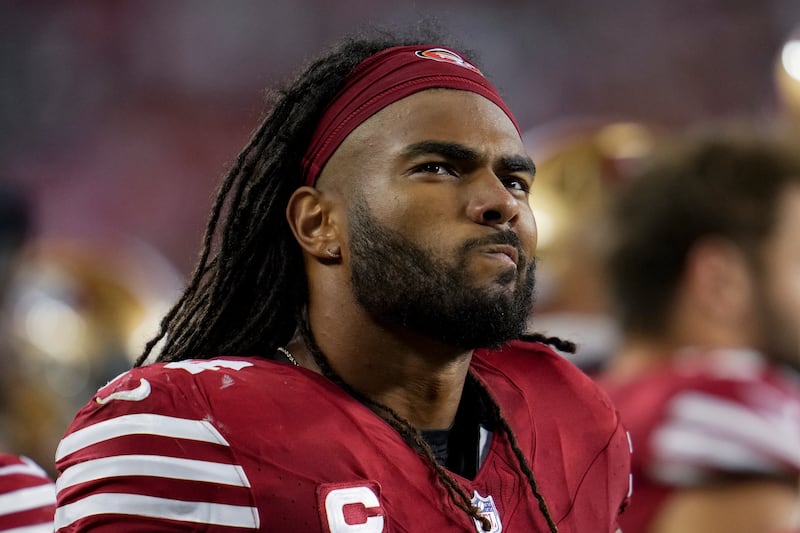
3) Todd Christensen (second round/1978, tight end) — Christensen was a fullback at BYU but converted to tight end in the NFL and redefined the position. It is a glaring omission that he is not in the NFL Hall of Fame. After failing to catch on with the Cowboys and Giants, he found a home with the Raiders. He caught 461 passes for 5,872 yards and 41 touchdowns. In eight playoff games he added another 31 catches for 358 yards and one touchdown. He twice led the league in receptions and he was a key part of two Super Bowl championship teams. In 1986, he caught 95 passes — an NFL record for tight ends at the time — for 1,153 yards and eight touchdowns. He was named to five Pro Bowl teams and was a two-time All-Pro. At a time when tight ends were mostly extra tackles, he helped revolutionize the position.
4) Bart Oates (undrafted/1983, center) — Oates was a winner everywhere he went. He won four conference championships in four years with BYU, two USFL championships in three years with the Philadelphia/Baltimore Stars, and three Super Bowl championships (two with the Giants, one with the 49ers) in 11 NFL seasons. He played in five Pro Bowls. (He also earned a law degree in the offseason.) During those 11 years in the NFL, he never missed a game, despite playing a position that put him in the middle of the trenches. He played in all 172 games. Like Christensen, he has somehow not been named to the NFL Hall of Fame.
5) Jim McMahon (first round, No. 5/1982, quarterback) — BYU coach LaVell Edwards told the Bears that McMahon would take them to the Super Bowl, and four years later McMahon did just that. The Bears won what is still their only championship. McMahon’s career produced mixed results, though. He led the Bears to six straight wins to start the following season and they seemed headed for another Super Bowl appearance, but McMahon was injured in the sixth game. He missed the rest of the season and the Bears were stopped in the playoffs. McMahon was injured for much of his career after that, although he managed to win 22 consecutive regular-season games from 1984 to 1987, which was an NFL record for a quarterback at the time (Peyton Manning eventually won 23). McMahon played 15 seasons for six teams and totaled 100 touchdown passes (90 interceptions), 18,148 yards, 1,631 rushing yards and 16 rushing touchdowns. His won-lost record: 67-30. He played in one Pro Bowl. McMahon had an 8-3 record with the Eagles and an 8-4 record with the Vikings, but they went nowhere in the playoffs. He was a backup the last three years of his career. It didn’t help McMahon’s cause that he played seven years for Mike Ditka, a conservative coach who was reluctant to turn his quarterback loose the way BYU did. If McMahon came along in this era and was drafted by the right team (not the Jets), he would thrive.
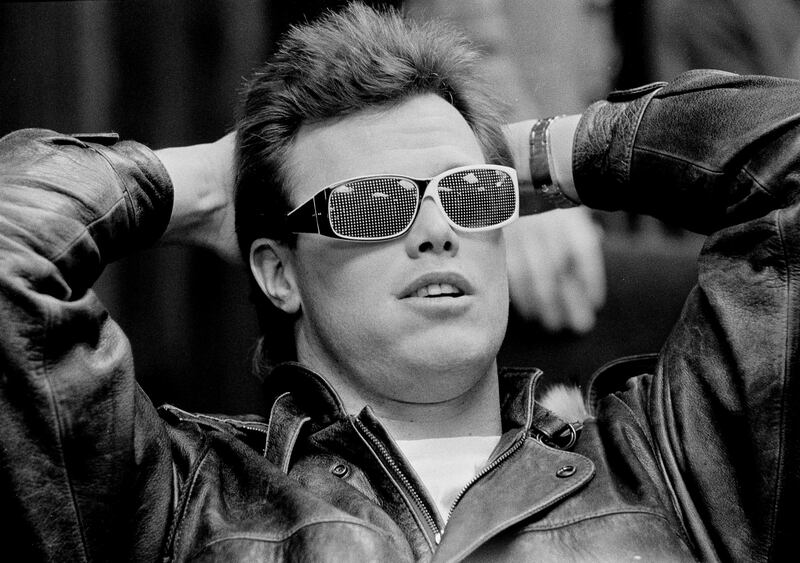
6) Chad Lewis (undrafted/1997, tight end) — First, he walked on at BYU, then he walked on to the NFL (as an undrafted free agent). He wound up catching 229 passes for 2,361 yards and 23 touchdowns. He caught another 38 passes for 409 yards and three TDs in the playoffs, including the game winner in the 2005 conference championship game. He broke his foot on that play and couldn’t play in the Super Bowl. He was named to three Pro Bowl teams and was named second-team All Pro one season during an eight-year NFL career.
7) Kurt Gouveia (eighth round/1986, linebacker) — BYU coach LaVell Edwards was surprised when Gouveia went so late in the draft. “He’s only the best linebacker we’ve ever had,” said the coach. Gouveia played 13 seasons in the NFL and won two Super Bowls. The numbers: 837 tackles, 12 interceptions, eight forced fumbles. During the 1991 season, he had interceptions in three consecutive postseason games, including one in the Super Bowl.
8) Brett Keisel (seventh round/2002, defensive end) — During his 13 seasons with the Steelers, Keisel played in three Super Bowls (winning two) and one Pro Bowl. He totaled 408 tackles (253 solo), 33 tackles for loss, 30 sacks, two interceptions, and one touchdown. It was a remarkable career for a player who didn’t really distinguish himself at BYU (no all-conference honors or exceptional stats).

9) Rex Berry (14th round/1951, defensive back) — Berry has been overlooked or forgotten in any discussion about BYU greats. “The Carbon Comet,” as he was known at Carbon High in Price, served four years in the Navy during World War II and spent a year in junior college before finding his way to BYU. As a result, he got a very late start. He didn’t begin his professional career until he was 27. During his six seasons in the NFL — all for the 49ers — he collected 22 interceptions, 404 return yards, three defensive touchdowns and eight fumbles. In 1953, he intercepted seven passes in 12 games, returning them for 142 yards and one touchdown, and recovered two fumbles. He was the 49ers’ team captain. Berry retired from football at the age of 32 (his family says he made about $12,000 in his final season).
10) Kyle Van Noy (second round/2014, linebacker) — Now in his 10th season, Van Noy has totaled 471 tackles, 47 tackles for loss and 33.5 sacks, and been a part of two Super Bowl championships. He was named to the Patriots’ all-decade team. He is currently a backup with the Ravens, his fifth team (not counting two different stints with the Patriots).
11) Jamaal Williams (fourth round/2017, running back) — Williams made a name for himself as primarily a backup with the Packers for four seasons, and then he moved to the Lions in 2021 and became a starter. Last season he rushed for 1,066 yards and an NFL-leading 17 touchdowns (a Lions franchise record). He signed with the Saints in the offseason but after just two games he was placed on injured reserve. Career totals: 3,652 yards, 30 touchdowns, 160 catches for 1,191 yards and eight touchdowns.
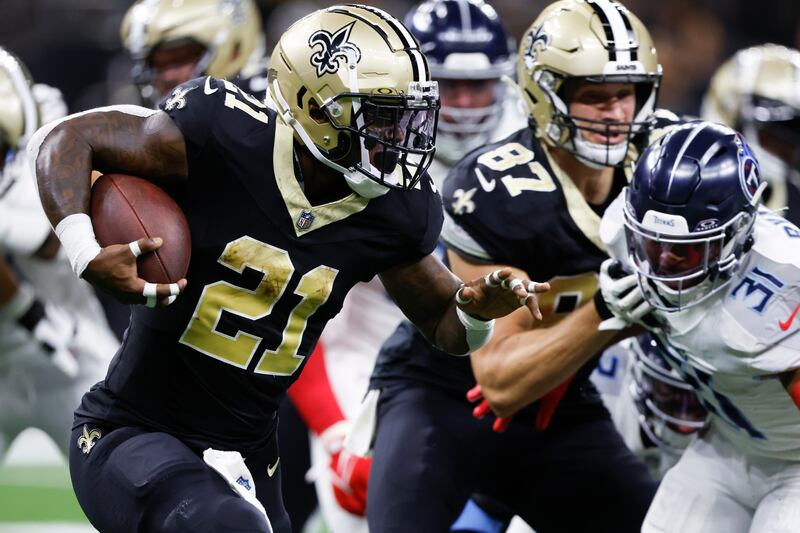
12) (tie) — Dennis Pitta (fourth round/2010, tight end), Austin Collie (fourth round/2009, wide receiver) — It was difficult to know what to do with Pitta and Collie. They were successful NFL players, but both of them had their careers cut short by injuries. In the end, they accomplished too much to be left off the list.
Collie landed in the perfect place as a rookie, playing slot receiver for the Colts and quarterback Peyton Manning. As a rookie, he caught 60 passes for 676 yards and seven touchdowns. In the Super Bowl he had six catches for 66 yards. His second season was more of the same and he became a favorite target of Manning, but he was concussed in the ninth game and left the field on a stretcher after being hit on both sides of his head by converging tacklers. He had another concussion six weeks later. He still almost matched his rookie year, catching 58 passes in just nine games for 649 yards and eight touchdowns. He managed to play the entire 2011 season with similar results, but in a 2012 preseason game he suffered his third concussion, which was followed later by a knee injury in his one and only regular-season game. He was not re-signed by the Colts the following season. He played in seven games for the Patriots but caught only six passes. After five seasons, he was out of the league. His career stats: 49 games, 179 catches, 1,908 yards, 16 touchdowns (all but seven of those catches occurred in the first three seasons). He played one season in the CFL and caught 43 passes, then he announced his retirement.
Pitta, who walked on at BYU as a wide receiver, had a breakout year in his second season, catching 40 passes. In the AFC championship game, he caught five passes and scored the Ravens’ first touchdown. In his third season, he moved into a starting role and he went on to catch 61 passes, seven for touchdowns. He collected another 14 catches and three touchdowns in the playoffs, including four receptions and a touchdown in the Ravens’ Super Bowl victory. A few months later, he broke and dislocated his right hip during training camp and immediately underwent surgery. To the surprise of many, he managed to return in the 14th game and caught six passes, one for a touchdown, and in the offseason the Ravens signed him to a five-year $32 million contract. But in the third game of the following season, he broke and dislocated his right hip again and missed the entire 2015 season. Doctors reportedly told Pitta he should retire, but he returned to the game in 2016 anyway and he produced his best season with career highs of 86 catches, 729 yards and two touchdowns. It proved to be his final season. The following summer he dislocated the right hip again. His career totals: 66 games, 224 catches, 2,098 yards, 13 touchdowns.
What follows is a list of other players you could easily make a case for inclusion in the top 12:
Rob Morris (first round/2000, linebacker) — He started at middle linebacker for the Colts for five seasons and finished an eight-year career with 482 tackles (356 solo). During the 2001 season he had 114 tackles (84 solo). He had four solo tackles in the Colts’ Super Bowl victory in 2007.
Daniel Sorensen (undrafted/2000, safety) — Like Oates and Lewis, he carved out a great career after being ignored in the draft — nine seasons (eight with the Chiefs), 432 tackles, 14 interceptions, 36 pass deflections, four defensive touchdowns. And he won a Super Bowl ring with Kansas City.
Ezekiel Ansah (first round/2013, defensive end) — He played eight seasons (seven for the Lions), and made 236 tackles, 63 tackles for loss and 50.5 sacks. He was selected for one Pro Bowl.
John Tait (first round/1999, tackle) — He played 10 seasons with the Chiefs and Bears, 148 games, 139 starts.
Vai Sikahema (10th round/1986, returner/running back) — He played eight seasons for the Cardinals, Packers and Eagles and was selected for two Pro Bowls. He was primarily a punt and kickoff returner (he returned four punts for touchdowns, one for 87 yards). He saw action at running back in four of those seasons and was used primarily as a receiver (53 catches, 537 yards, one touchdown).
Marc Wilson (first round/1980, quarterback) — He was in and out of the lineup during a 10-year career (mostly with the Raiders), throwing for 14,391 yards, 86 touchdowns and 102 interceptions.
Jason Buck (first round/1986, defensive end) — His best seasons occurred in 1988 and 1989, when he produced a combined total of 12 sacks. He played in two Super Bowls, one with Cincinnati (a loss) and one with Washington (a win), and came away with one sack in both games.
Brady Poppinga (fourth round/2005, linebacker) — He played eight seasons, six with the Packers, totaling 308 tackles (226 solo) in 100 games.
